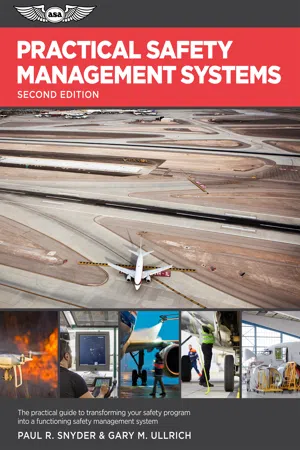
Practical Safety Management Systems
A Practical Guide to Transform Your Safety Program into a Functioning Safety Management System
- 216 pages
- English
- ePUB (mobile friendly)
- Available on iOS & Android
Practical Safety Management Systems
A Practical Guide to Transform Your Safety Program into a Functioning Safety Management System
About this book
The practical guide to transforming your safety program into a functioning safety management system
The advent of the safety management system (SMS) has affected all aviation sectors worldwide, and is now required for most domestic and international air operations, through either regulatory (14 CFR Parts 5, 119, or 121) or voluntary compliance. It's easy to be intimidated by the scope and complexity of SMS, but Practical Safety Management Systems distills the concepts and principles into a practical working format. Universities and training organizations will find guidance and resources to create, implement, and maintain a functioning SMS.
An SMS must be adapted and continuously improved to meet an organization's mission while reducing risk to the lowest viable level for flight departments, independent contractors servicing the aviation industry, air traffic services, and more. Beyond mere theory, this book encourages hands-on exercise and practical application of SMS concepts and principles to varied industry areas such as flight crews, maintenance, air traffic control, airports, and unmanned aircraft systems (UAS).
Beginning with an overview and history of SMS, chapters cover SMS components, costs and development process, approaches to safety culture, human factors, audits and evaluations, and more. Each chapter concludes with review questions. Extensive case studies and references are provided throughout, with additional resources supplied in a "Reader Resources" webpage. Practical Safety Management Systems is a useful guide for transforming your safety program into an up-to-date and beneficial safety management system.
Frequently asked questions
- Essential is ideal for learners and professionals who enjoy exploring a wide range of subjects. Access the Essential Library with 800,000+ trusted titles and best-sellers across business, personal growth, and the humanities. Includes unlimited reading time and Standard Read Aloud voice.
- Complete: Perfect for advanced learners and researchers needing full, unrestricted access. Unlock 1.4M+ books across hundreds of subjects, including academic and specialized titles. The Complete Plan also includes advanced features like Premium Read Aloud and Research Assistant.
Please note we cannot support devices running on iOS 13 and Android 7 or earlier. Learn more about using the app.
Information
- Define the definition of Safety Management System (SMS).
- Recall the history which led to the international requirement for an SMS Program.
- Describe the United States statuary requirement to establish an SMS Program.
- Explain the history of the SMS Pilot Programs.
- Summarize the important parts of 14 CFR Part 5.
- List and define the three levels of the SMS Voluntary Program (SMSVP).
- Recall the four components of SMS.
- 14 CFR Part 5
- FAA Certificate Management Team (CMT)
- ICAO Annex
- ICAO Standards and Recommended Practices (SARPs)
- International Civil Aviation Organization (ICAO)
- Safety Assurance (SA)
- Safety Management System (SMS)
- Safety Policy
- Safety Promotion
- Safety Risk Management (SRM)
- SMS Pilot Project
- SMS Voluntary Program (SMSVP)
- SMSVP Active Applicant
- SMSVP Active Conformance
- SMSVP Active Participant
- A structured means of safety risk management decision-making.
- A means of demonstrating safety management capability before system failures occur.
- Increased confidence in risk controls though structured safety assurance processes.
- An effective interface for knowledge sharing between regulator and certificate holder.
- A safety promotion framework to support a sound safety culture.
- Safety policy;
- Safety risk management (SRM);
- Safety assurance (SA); and
- Safety promotion.
Table of contents
- Introduction
- 1. Overview and History of Safety Management Systems
- 2. Understanding the Components of an SMS
- 3. SMS Costs Versus Benefits
- 4. Safety Management Systems Versus Safety Programs
- 5. Scalability of SMS
- 6. Basic Safety Concepts
- 7. SMS Planning and Process
- 8. Transitioning Your Safety Program to a Safety Management System
- 9. Developing a Safety Policy for Your Organization
- 10. Safety Risk Management
- 11. Safety Assurance and Continuous Monitoring
- 12. Safety Assurance: Audits and Evaluations
- 13. SMS and Your Safety Culture
- 14. Creating Your SMS Manual
- Glossary
- Index